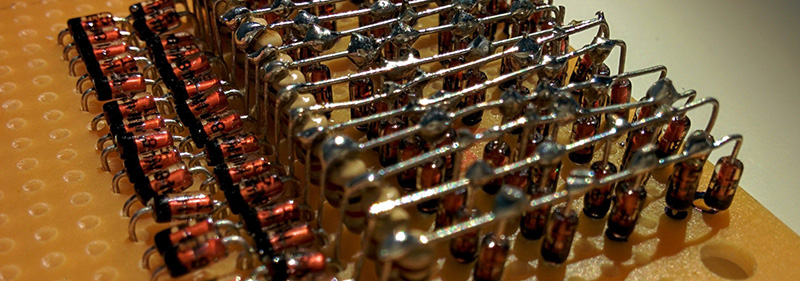The apocalypse is coming, and the last time I checked, not many people have a semiconductor fab in their garage. We’ll need computers after the end of the world, and [matseng]’s project for the Hackaday Prize is just that – a framework to build computers out of discrete components.
The apocalyptic spin on this project is slightly exaggerated, but there is a lot someone can learn by building digital devices out of transistors, resistors, and diodes. The building blocks of [matseng]’s computer are as simple as they come: he’s using three resistors, four diodes, and one NPN transistor to build a single NAND gate. These NAND gates can then be assembled into any form of digital logic. You’re never going to get a better visual example of functional completeness.
A project like this must be approached from both the top down and bottom up. To go from a high level to ones and zeros, [matseng] built an assembler and an emulator. Some ideas of what the instruction set will be are laid out in this project log, and for now [matseng] is going for a Harvard architecture with eight registers. It’s a lot of work for a computer that will be limited by how much memory [matseng] can be wired up, but as far as ambition goes, there aren’t many projects in the Hackaday Prize that can match this tiny, huge computer.





















Pretty amazing to build a full CPU without using a single chip, especially considering the 4004 (the world’s first single-cup CPU) has over 2000 transistors in it.
Konrad Zuse built the mechanical floating-point processor, and then the same thing with telephone relays.
I also like http://hackaday.com/2015/05/08/relays-calculate-square-roots/
Something like this makes me believe in humanity again. With such guys on board we will go from apocalypse event to full technical civilization in no more than 50 years.
There is a massive scene on minecraft where people build functional computers all the way from 2bit to 32 bit. I know it’s a game but these computers work and are like real world examples.
This is pretty cool.
How’s irs crysis 3 performance?
If you liked this, do not miss: http://members.iinet.net.au/~daveb/simplex/ringhome.html
That’s neat Hackaday but I wish we could have semiconductor fabs in our garages.
It’s often not practical and if you want to make small, reliable devices you are probably out of luck (due to cost), but basic semiconductor fab isn’t actually very hard. Keeping it clean and consistent so that you get good devices in the end is another story. But that being said you could totally do it.
Jeri Ellswort did it: https://youtu.be/-Qph8BNrnLY
Exactly! My comments are that she has a good amount of gear that most people are going to have to go find that will cost a bit (although she does it without a lot of typical gear) and in her videos she talks constantly about ones that don’t turn out due to various debris or processing errors. Due to these things her devices are often very large compared to what a lower end clean room lab would be able to make, but as a play with this, play with that and see what the results are it works fine. It would be impractical to manufacture large quantities of devices this way. I do however believe that this is a good process for most people in the field to have been through and understand.
You should find an old Cray. Those towers are stacks of small PCBs with ECL and discrete parts.
I’ll just leave this here:
https://hackaday.io/list/2402-homebrew-computers
Building a NAND gate is a long way from building even an 8-bit CPU. A close reading of the article does not indicate that he has actually built anything other than a NAND gate. Planning something is not the same thing as DOING it.
Well, you must be bad doing”close reading” :-) Or you didn’t follow the link into the actual project. I got the discrete UART working which also contains latches and other glue logic built from the basic nand gates. An also a working version of a 4-to-16 decoder which I will require a few of in total. So it’s a little bit further than a single nand gate. But this project is *major* and will not be finalized for a looong time – that much is true.